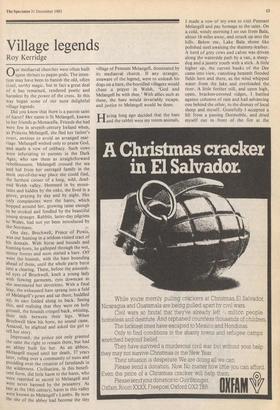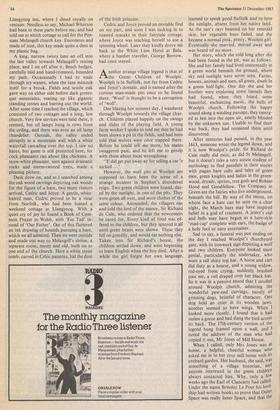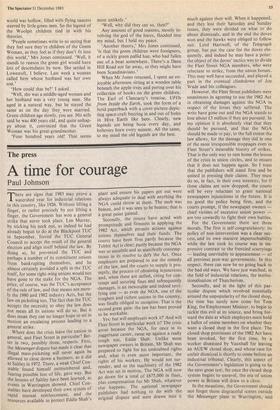Village legends
Roy Kerridge
Our mediaeval churches were often built upon shrines to pagan gods. The inten- tion may have been to banish the old, often
cruel, earthy magic, but in fact a great deal of it has remained, rendered poetic and harmless by the power of the cross. In this way began some of our most delightful village legends.
Did you know that there is a patron saint of hares? Her name is St Melangell, known to her friends as Monacella. Friends she had were few in seventh-century Ireland when, as Princess Melangell, she fled her father's court, anxious to avoid an arranged mar- riage. Me!angell wished only to praise God, and made a vow of celibacy. Such vows were infuriating to parents in the Dark Ages, who saw them as straightforward rebelliousness. Melangell crossed the sea and hid from her outraged family in the most out-of-the-way place she could find, the furthest corner of a long, wild, dead- end Welsh valley. Hemmed in by moun- tains and hidden by the oaks, she lived in a grove, praying by day and by night. Her only companions were the hares, which hopped around her, growing tame enough to be stroked and fondled by the beautiful young stranger. Rabbits, latter-day pilgrims to Wales, had not yet been introduced by the Normans.
One day, Brochwell, Prince of Pawls, was out hunting in a seldom-visited tract of his domain. With horse and hounds and hunting-horn, he galloped through the wet, mossy forests and soon started a hare. Off went the hounds, with the hare bounding ahead of them, until the whole party burst into a clearing. There, before the astonish- ed eyes of Brochwell, knelt a young lady with flowing garments, eyes downcast as she murmured her devotions. With a final leap, the exhausted hare sprang into a fold of Melangell's gown and sat there, huddled UP, its ears folded along its back. Seeing this, and realising that they were on holy ground, the hounds cringed back, whining, their tails between their legs. When Brochwell blew his horn, no sound came. Amazed, he alighted and asked the girl to tell her story. Impressed, the prince not only granted the saint the right to remain there, but had
ankk
a--ey built for her. As an abbess, Melangell stayed until her death, 37 years later, ruling over a community of nuns and presiding over the creation of farmlands in the wilderness. Civilisation, in this benefi- cent form, did little harm to the hares, who were regarded as sacred to Melangell and were never harmed by the peasantry. As late as the 18th century, hares in this valley were known as Melangell's Lambs. By now the site of the abbey had become the tiny village of Pennant Melangell, dominated by its mediaeval church. If any stranger, unaware of the legend, were to unleash his dogs on a hare, the horrified villagers would chant a prayer in Welsh, 'God and Melangell be with thee.' With allies such as these, the hare would invariably escape, and justice to Melangell would be done.
Having long ago decided that the hare and the rabbit were my totem animals, I made a vow of my own to visit Pennant Melangell and pay homage to the saint. On a cold, windy morning I set out from Bala, about 16 miles away, and struck up into the hills. Below me, Lake Bala shone like polished steel awaiting the shammy-leather. A herd of grey cows and calves was driven along the waterside path by a van, a sheep- dog and a jaunty youth with a stick. A little higher up, the curved banks of the Dee came into view, vanishing beneath flooded fields here and there, as the wind whipped water from the lake and overloaded the river. A little further still, and upon high, open, bracken-covered ridges, I battled against columns of rain and hail advancing one behind the other, to the dismay of local sheep and myself. Gratefully I accepted a lift from a passing Dormobile, and dried myself out in front of the fire at the
Llangynog inn, where I dined royally on venison. Needless to say, Michael Wharton had been in these parts before me, and had told me at which cottage to call for the Pen- nant Melangell church key. Enormous and made of iron, this key made quite a dent in my plastic bag.
A long, narrow twisty lane set off into the last valley towards Melangell's resting place, and I set off after it. Beech hedges, carefully laid and hand-trimmed, bounded my path. Occasionally I had to wade through icy waters, when the lane mistook itself for a brook. Fields and sessile oak gave way on either side before dark grotes- que mountains, rearing up like gigantic standing stones and barring out the world. After some time I reached the village, which consisted of two cottages and a long, low church. Very few services were held there, it seemed, but oil lamps hung in rows from the ceiling, and there was even an oil lamp chandelier. Outside, the valley ended abruptly in a mountain wall with a white waterfall cascading over the top. I saw no hares, but game is still protected here, for cock pheasants ran about like chickens. A snow-white pheasant, seen against dramatic rocks and storm-twisted trees, made a pleasing picture.
Dusk drew on, and as I searched among the oak wood carvings depicting oak woods for the figure of a hare, two more visitors arrived, Cedric and Joyce. A gentle, white- haired man, Cedric proved to be a vicar from Norfolk, who had been loaned a weekend cottage at Llangynog. With a quiet cry of joy he found a Book of Com- mon Prayer in Welsh, with Tin Tad' in- stead of 'Our Father'. Out of this fluttered an ink drawing of hounds pursuing a hare, which we all admired. Then we went outside and made our way to Melangell's shrine, a separate room, musty and old, built on to one end of the church. Here a white stone tomb, carved in Celtic patterns, hid the dust of the Irish princess.
Cedric and Joyce proved an enviable find on my part, and soon I was tucking in to toasted teacake in their fairytale cottage, where Joyce was teaching herself to use a spinning wheel. Later they kindly drove me back to the White Lion Hotel at Bala, where a hardier traveller, George Borrow, had once stayed.
A nother strange village legend is that of the Green Children of Woolpit. Woolpit is in Suffolk, not far from Cedric and Joyce's domain, and is named after the curious man-made pits once to be found there. 'Wool' is thought to be a corruption of 'wolf'.
One blazing hot summer day, I wandered through Woolpit towards the village chur- ch. Children played happily on the swings and slides of the playing field. A young farm worker I spoke to told me that he had been shown a pit in the fields, and had been told that wolves were once trapped there. Before he could tell me more, his mates swaggered past, and he left me to gossip with them about local wrongdoing.
"E did get put away-ay for selling a car 'e nicked. . '
However, the wolf pits at Woolpit are supposed to have been the scene of a strange incident in Stephen's disordered reign. Two green children were found, daz- ed by the sunlight, in one of the pits. They were green all over, and wore clothes of the same colour. Astounded, the villagers ran and told the lord of the manor, Sir Richard de Cain, who ordered that the newcomers be cared for. Every kind of food was of- fered to the children, but they ignored it all until green beans were shown. These they fell on greedily, and would eat nothing else. Taken into Sir Richard's house, the children settled down, and were beginning to learn English when the boy died. After a while the girl forgot her own language, learned to speak good Suffolk and to love the sunlight, absent from her native land. As the sun's rays beamed on her emerald skin, her vegetable hues faded, and she became a normal pink, pretty, Woolpit girl. Eventually .she married, moved away and was heard of no more.
Her story, which she told long after she had been found in the pit, was as follows. She and her family had lived contentedly in a green world beneath the ground, where sky and sunlight were never seen. Farms, houses, animals and men, all green, dwelt in a green half-light. One day she and her brother were exploring some tunnels they had found, when they heard some beautiful, enchanting music, the bells of Woolpit church. Following the happy sound along a winding passage, they emerg- ed at last into the open air, nearly blinded by the unknown sun. Unable to find their way back, they had remained there until discovered.
After centuries had passed, in the year 1613, someone wrote the legend down, and it is now Woolpit's pride. Sir Richard de Cain really did exist, as did St Melangell, but it doesn't take a very astute student of mythology to find parallels in their stories with pagan hare cults and tales of green men, green knights and ladies in the green- wood, dryads, sprites, tree gods and Robins Hood and Goodfellow. The Company in Green are the fairies who live underground, beneath the hill. By way of the moon, on whose face a hare can be seen on a clear night, the March hare may have inspired belief in a god of craziness. A jester's cap and bells may have begun as a hare-skin `mad-cap' complete with ears, the badge of a holy fool or zany entertainer.
Sad to say, a funeral was just ending on the day I reached Woolpit's churchyard gate, with its ironwork sign depicting a wolf and two children. Everyone looked most genial, particularly the undertaker, who wore a tall shiny top hat. A horse and cart did duty as a hearse, and a young widow, red-eyed from crying, suddenly brushed past me, a veil draped over her black hat. So it was in a pensive mood that I strolled around Woolpit church, admiring the wonderful pew-end carvings, mostly of grinning dogs, brimful of character. One dog held an otter in its wooden jaws, another seemed to have wings. When I looked more closely, I found that it had stolen a goose and had slung the bird across its back. The 17th-century version of the legend hung framed upon a wall, and I noted the address of the man who had copied it out, Mr Jones of Mill House.
When I called, only Mrs Jones was at home, a helpful, cheerful woman who asked me in to her cosy mill home with its orchard garden. Her husband, she said, was something of a village historian, and anyone interested in the green children always contacted him. Why, only a few weeks ago the Earl of Clancarty had called. Under the name Brinsley Le Poer his lord- ship had written books to prove that Outer Space was really Inner Space, and that the
world was hollow, filled with flying saucers steered by little green men. So the legend of the Woolpit children tied in with his theories.
'People sometimes write to us saying that they feel sure they're children of the Green Woman, as they feel as if they don't fit into this world,' Mrs Jones continued. 'Well, it stands to reason the green girl would have lots of descendants by now. She settled in Lowestoft, I believe. Last week a woman called here whose husband was her own son.'
'How could that be?' I asked.
'Well, she was a middle-aged woman and her husband was a very young man. She aged in a natural way, but he stayed the same as on the day they were married. Green children age slowly, you see. His wife said he was 400 years old, and quite unhap- py about it, convinced that the Green Woman was his great-grandmother.
'Four hundred years old! That seems most unlikely.'
'Well, why did they say so, then?'
Any amount of good reasons, mostly in- volving the god of the hares, flooded into my mind, but I held my peace.
'Another theory,' Mrs Jones continued, 'is that the green children were foreigners, of a sickly green pallid hue, who had fallen out of a boat somewhere. There's.a Dane Hill Road not far away, so they might have been Scandinavians.'
When Mr Jones returned, I spent an en- joyable afternoon sitting at a wooden table beneath the apple trees and poring over his collection of books on the green children. The Earl of Clancarty's treatise, UFOs from Inside the Earth, took the form of a lurid paperback with a cover-picture depic- ting space-craft buzzing in and out of holes in Hive Earth like bees. Clearly, new legends are being born every day, and believers born every minute. All the same, to my mind the old legends are the best.
















































 Previous page
Previous page